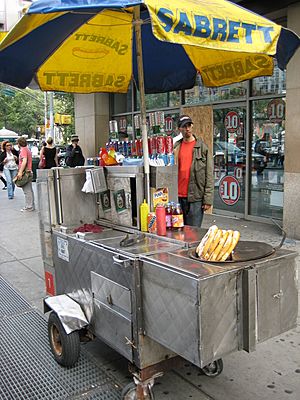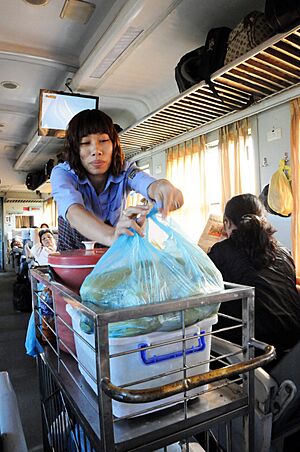Food cart facts for kids


A food cart is like a small, movable kitchen on wheels. It's set up on the street to make and sell street food to people walking by. You can find food carts in cities all over the world, selling many different kinds of food.
Food carts usually come in two main types. In one type, the person selling the food can sit or stand inside the cart and serve food through a window. In the other type, the seller stands next to the cart. All the space inside this cart is used for storing food and holding cooking equipment, like a grill. The kind of food being sold often decides which style of cart is used.
Food carts are different from food trucks. Food trucks can drive on their own, but food carts cannot. Some food carts are pulled by another vehicle, while others are pushed by a person or even an animal.
The History of Food Carts
The very first food carts probably appeared a long, long time ago. This was during the time of the ancient Greek and Roman civilizations. Traders would change old hand-carts or smaller carts pulled by animals into mobile shops. Carts were great because they could move easily. If a spot wasn't selling much, the seller could just move the cart. They also helped transport goods to and from storage.
The use of carts really grew when railways became popular. Here's why:
- Early train carriages were often open, so passengers needed food and drinks to stay warm.
- Trains had to stop often to get coal and water. This gave passengers a chance to use restrooms, eat, and drink.
- Most early trains did not have special buffet or dining cars for food.
- When passengers arrived at their destination, they often needed a quick meal or drink, especially those who couldn't afford to stay in fancy hotels.
This growth led to a good relationship between mobile sellers and the railway companies. Some of the first rules for selling food on railway property came from this. You can still see this type of selling today in many countries, especially at smaller train stations in places like Africa and Southeast Asia.
Railways also provided another benefit: many old carts. Traders who needed new carts would often buy old luggage carts from train stations. They would then change these carts to sell food. These carts were already the right size to fit through doors and on lifts.
Today, food carts are generally bigger. Many are pulled by larger vehicles like 4x4s. But you can still see hand-pushed food carts in places where it's hard for vehicles to go, especially where there are many hungry people.
Modern Food Cart Design
In the 21st century, food carts have become more advanced. New designs include carts made from strong materials like stainless steel, fiber-reinforced plastic, and aluminum. Some new carts have even been designed to drive themselves!
Some food carts are connected to regular restaurants. Often, the food sold from the cart is the same as the food you would find in the restaurant.
See also
 In Spanish: Puesto ambulante de comida para niños
In Spanish: Puesto ambulante de comida para niños



